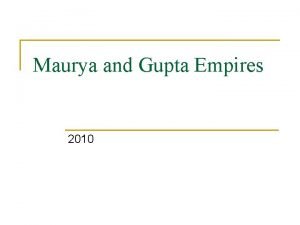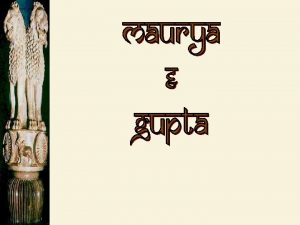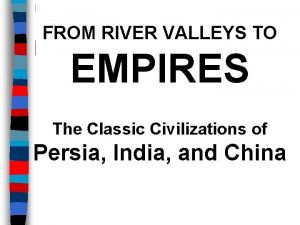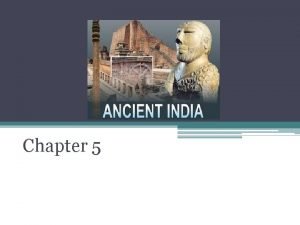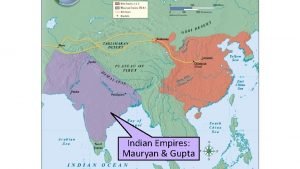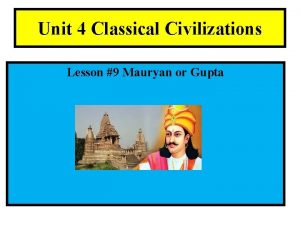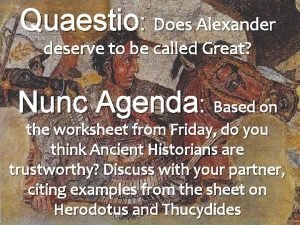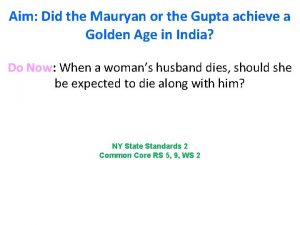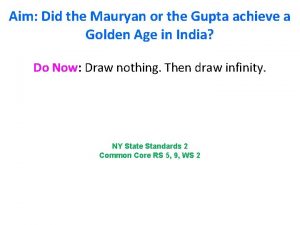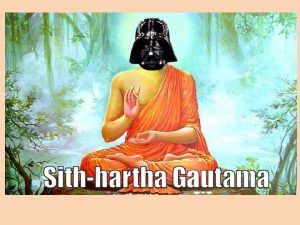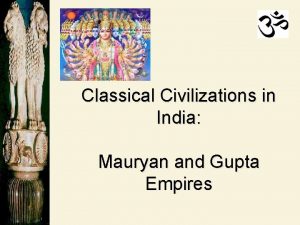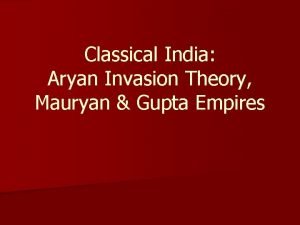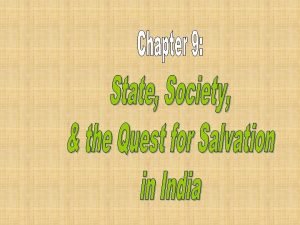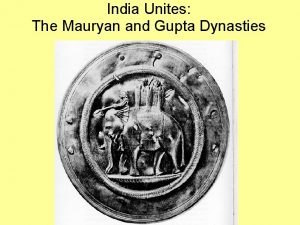Aim Do the Mauryan or Gupta deserve to




















- Slides: 20

Aim: Do the Mauryan or Gupta deserve to be called Classical civilizations? NY State Standards 2 Common Core RS 5, 9, WS 2 Statue of Chandragupta Maurya


I Rise of the Mauryan Empire (323 -185 BCE) A) Prior to the arrival of Alexander the Great, India was mostly composed of small independent states, with the exception of Northern India ruled by the Nanda dynasty. B) 326 BCE Alexander the Great conquered northern Indian and made it into a Macedonian tribute state. But his army refused to go any further into Asia; the Macedonian army turned back and left India. C) Chandragupta was a noble of the Kshatriya (warrior) caste, related to the Nanda family but in exile. After the death of Alexander the Great in 323 BCE, General Seleucus took control of the Eastern Macedonian territories. Chandragupta raised an army and attacked Seleucus. In 305 BCE, Chandragupta signed a treaty with Seleucus, and the land was given to Chandragupta in exchange for 500 war elephants. D) 322 BCE Chandragupta seized the throne in Pataliputra, ending the Nanda dynasty. After defeating the rest of Alexander’s generals, he created the first unified Indian Empire.

General Seleucus

Pataliputra

II King Asoka (Ruled 270 - 232 BCE) A) King Asoka was Chandragupta’s grandson. Born Hindu, he converted to Buddhism in 262 BCE and sought to spread Buddhism throughout his empire. B) He erected the Edicts of Asoka (stone pillars) that listed public works projects such as irrigation systems, roads, hospitals, and promoted Buddhist beliefs. They were written in Brahmi, Greek and Aramaic! “…While being completely law-abiding, some people are imprisoned, treated harshly and even killed without cause so that many people suffer. Therefore your aim should be to act with impartiality. It is because of… envy, anger, cruelty, hate, indifference, laziness or tiredness -- that such a thing does not happen. . . This edict has been written for the following purpose: that the judicial officers of the city may strive to do their duty and that the people under them might not suffer unjust imprisonment or harsh treatment…” Edicts of Asoka, Kalinga

Asoka And the Expansion of Buddhism “…During the expansion of the Mauryan Empire, Asoka led a war against feudal state Kalinga 261 BCE. . . with around 300, 000 casualties. . . Allegedly Asoka was so horrified that despite having called himself a Buddhist for 2 years prior to the war, he began to take the tenants of Buddhism seriously. After the war… Asoka stopped his expansion policy. India for a time became at least somewhat peaceful, and he erected numerous pillars with his Edicts… Asoka turned Buddhism into a state religion and encouraged Buddhist missionary activity. . . Prior to Asoka Buddhism was a relatively minor tradition in India. . . Was Asoka a true follower of the Buddhist doctrine or was he simply using Buddhism as a way of reducing social conflict by favoring a tolerant system of thought and thus make it easier to rule over a nation composed of several states that were annexed through war? The intentions of Ashoka remain unknown. . . ” Cristian Violatti published on 02 September 2013

Pillar of Asoka, Vaishali, 3 rd century BCE

III Decline of the Mauryan Empire • • • Stupas are mound-like or hemispherical structures containing Buddhist relics (typically the ashes of Buddhist monks), used by Buddhists as a place of meditation. The Sanchi Stupa is the most famous stupa built by King Asoka. Weak kings after death of Asoka Military coup Division into smaller kingdoms and citystates

IV Rise of the Gupta (320 – 550 CE) A) 500 years after the Mauryan Empire ended, the Gupta came to power in 320 CE. B) The Gupta period is known as the golden age in Indian History. Chandragupta II gained territory militarily and through strategic political marriages. He was a patron of art, culture, literature and music. His son Kumaragupta built the Nalanda University. Chandragupta II Nalanda University


V Golden Age of the Gupta 1. Discovered the concepts of zero & infinity. Created our modern number system, including decimals. These numbers would later be diffused to Europe by way of Arabs (why they’re called “Arabic” numerals). 2. Invented vaccinations for smallpox. Plastic surgery. 3. Created monuments and art from iron. 4. Aryabhatta (an astronomer and mathematician) proved the earth rotates on its axis, explained solar and lunar eclipses, solved quadratic equations, decimal place value system with zero, and approximation of pie (π).


Iron Pillar, New Delhi, India

Vaccinations for Smallpox "Take the fluid of the pock on the udder of the cow. . . upon the point of a lancer, and lance with it the arms between the shoulders and elbows until the blood appears; then, mixing the fluid with the blood, the fever of the small-pox will be produced. ” –Dhanwantari, circa 550 CE

V Gupta Government & Society A) Center of government in Pataliputra. Adopted and promoted Hinduism. B) Center of life in villages. Caste system governed life. C) Patriarchal. Arranged marriages based on caste.

VI Sati/Suttee A) Sati (also called suttee) is the cultural practice among some Hindu communities by which a recently widowed woman either voluntarily or by force commits suicide as a result of her husband's death. Often the widow burns to death on her husband's funeral pyre, but she may also be buried alive with the husband's corpse or drowned. B) Sati as practice is first mentioned in 510 CCE. However, there is greater historical evidence of its existence during and after the Gupta. C) The later Muslim Mughal Dynasty tried to ban it, as well as the colonizing British. Today the practice is illegal in India, although it still occurs. Heaphy, Linda. 2017. https: //kashgar. com. au “Sati” is derived from the original name of the goddess Sati (Dakshayani), who self-immolated because she was unable to bear her father Daksha's humiliation of her (living) husband Shiva.

A) B) C) D) Decline of the Gupta Central Asian White Huns invaded 400 s Gupta military costly debt Problems disrupted trade Gupta rule ended 550 CE. Again India was divided into small kingdoms. Map of White Huns 500 CE

Focus Questions Fill in your Period 2 Civilization chart for the Mauryan and Gupta Empires. 1. How should King Asoka be remembered? Explain your position. 2. What were the 2 greatest achievements of the Gupta? 3. What was the practice of sati/suttee? Why do you think it was done? How can we prevent it from occurring today?

Key Vocabulary Arabic Numerals Aryabhatta Chandragupta II Chandragupta Maurya Edicts of Asoka Gupta Empire Infinity Iron Pillar of New Delhi King Asoka Mauryan Empire Pataliputra Sati/Suttee Smallpox Stupa Vaccination
 Chandragupta maurya ruled for _____years.
Chandragupta maurya ruled for _____years. Mauryan empire and gupta empire venn diagram
Mauryan empire and gupta empire venn diagram How did the mauryan empire’s army help to promote trade?
How did the mauryan empire’s army help to promote trade? The mauryan empire
The mauryan empire Mauryan empire mind map
Mauryan empire mind map Why mauryan empire decline
Why mauryan empire decline Mauryan people
Mauryan people Mauryan empire
Mauryan empire Why do you deserve this award
Why do you deserve this award Does alexander deserve to be called the great
Does alexander deserve to be called the great We deserve to dream
We deserve to dream Does alexander the great deserve his title
Does alexander the great deserve his title You deserve the glory and the honor song
You deserve the glory and the honor song If you deserve something you are
If you deserve something you are You deserve a break meaning
You deserve a break meaning Thế nào là hệ số cao nhất
Thế nào là hệ số cao nhất Slidetodoc
Slidetodoc Hệ hô hấp
Hệ hô hấp Tư thế ngồi viết
Tư thế ngồi viết Số nguyên tố là số gì
Số nguyên tố là số gì đặc điểm cơ thể của người tối cổ
đặc điểm cơ thể của người tối cổ
